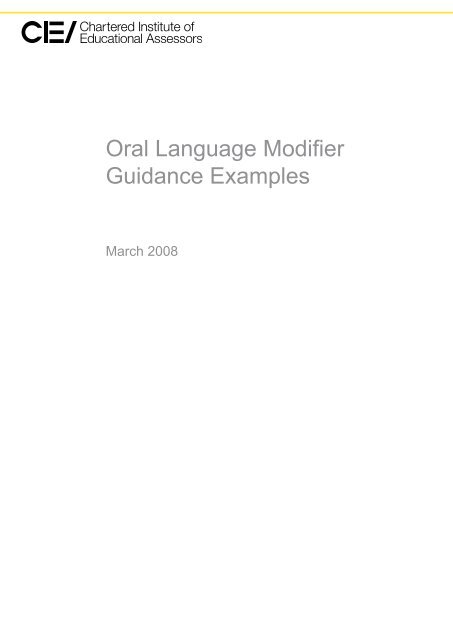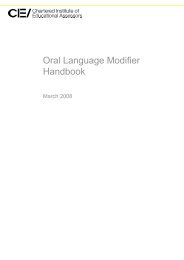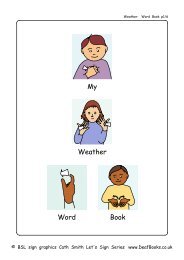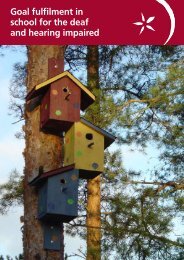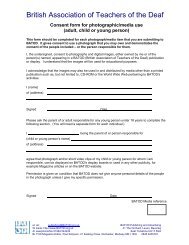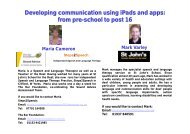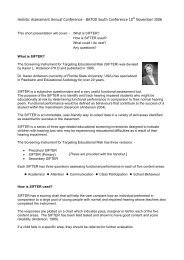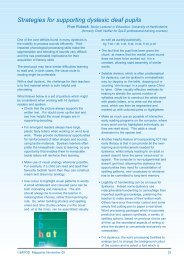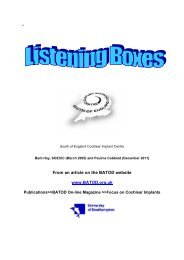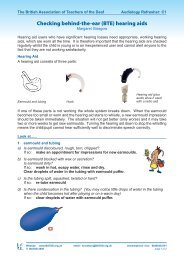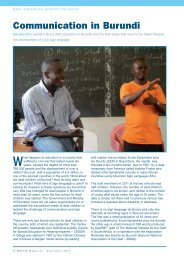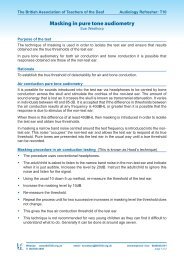Oral Language Modifier Guidance Examples - batod
Oral Language Modifier Guidance Examples - batod
Oral Language Modifier Guidance Examples - batod
You also want an ePaper? Increase the reach of your titles
YUMPU automatically turns print PDFs into web optimized ePapers that Google loves.
<strong>Oral</strong> <strong>Language</strong> <strong>Modifier</strong><br />
<strong>Guidance</strong> <strong>Examples</strong><br />
March 2008
Chartered Institute of<br />
Educational Assessors<br />
29 Bolton Street<br />
London W1J 8GP<br />
Tel 0845 672 2123<br />
info@ciea.org.uk<br />
www.ciea.org.uk
Contents<br />
Carrier <strong>Language</strong> 04<br />
Carrier <strong>Language</strong> in tasks and resources 04<br />
Complex sentences 05<br />
Elaborate <strong>Language</strong> for its own sake 06<br />
Vocabulary 06<br />
Jargon 07<br />
The Passive Voice 08<br />
Subordinate clauses 10<br />
Phrasal verbs 11<br />
Verbs vs Nouns – keep it active 12<br />
Ellipsis 13<br />
The negative 14<br />
Difficult word order 15<br />
Multiple meanings 17<br />
Idiom 17<br />
Confusion caused by metaphor - use literal language 18<br />
Coursework design 19<br />
Clarity of Instructions 20<br />
Appendix 1<br />
The language of modification<br />
Examination <strong>Language</strong><br />
Bloom’s Taxonomy<br />
Commonly encountered command words<br />
Other commonly used exam words<br />
Appendix 2<br />
OLM Checklist<br />
Appendix 3<br />
Glossary of Terms<br />
I<br />
I<br />
II<br />
II<br />
IV<br />
V<br />
VI<br />
VI<br />
VII<br />
VII
Carrier <strong>Language</strong><br />
Carrier <strong>Language</strong> in tasks and resources<br />
Introduction<br />
Carrier <strong>Language</strong> can be defined as the language used by the teacher to set a<br />
task or test, rather than that involved in teaching new concepts. This includes<br />
questions for all formal and informal tasks, tests and resource materials. There<br />
is of course no strict boundary between Carrier and other language, and most<br />
teaching, learning and assessment situations are a blend of many styles of<br />
communication. Carrier <strong>Language</strong> by definition is not the language being<br />
assessed, it should therefore be presented in the most simple format possible to<br />
allow all candidates to access the question or task being tested.<br />
Carrier <strong>Language</strong>, can be presented in oral, signed or written form, and can<br />
have effects on access to learning, and the assessment, of children.<br />
For example, deafness can affect a child’s linguistic development, both written<br />
and spoken. For some deaf children English may be their second language, with<br />
British Sign <strong>Language</strong> (BSL) their first.<br />
Children with language impairments including some of those with Autistic<br />
Spectrum Disorders (ASDs) will have verbal (and therefore written) difficulties<br />
that affect their acquisition and development of English vocabulary, grammar<br />
and syntax. In addition all children with ASDs have difficulties understanding<br />
and using language flexibly and appropriately to fit different contexts. This often<br />
means they misunderstand or get confused with ambiguous language, and<br />
may express themselves using more rigid or formal language than the situation<br />
requires. This will occur in both verbal and written language, and across both<br />
social and academic communication. Thus the language used explaining exam<br />
protocol may need to be modified as well as the language used within the exam<br />
papers.<br />
It is important to make Carrier <strong>Language</strong> as accessible as possible for the child,<br />
while acknowledging that he or she must be aware of appropriate technical<br />
terms or linguistic structures.<br />
Many of the examples on the following pages deal with modifications that can<br />
and should be made to Carrier <strong>Language</strong>.<br />
04 OLM <strong>Guidance</strong> <strong>Examples</strong>
Complex sentences<br />
Use short sentences where possible.<br />
Example<br />
The following GCSE Science question is unnecessarily complex:<br />
If a student were provided with three painted metal rods,<br />
one of which was known to be made from brass, one<br />
from magnetised steel and one from non-magnetised<br />
steel, describe how, without scratching the paint, the<br />
student could identify each of the rods.<br />
This redraft presents the same information more simply:<br />
A student has three painted metal rods. One is made<br />
from brass, one from magnetised steel and one from<br />
non-magnetised steel. Describe how the student could<br />
find out which rod is which, without scratching the paint.<br />
There are still problems with this.<br />
The list of three items is in a sentence – bullet points would make this clearer.<br />
The word “Describe” can be confusing. The question is really asking for an<br />
explanation of the process that would be used – so ask for an explanation:<br />
A student has three painted metal rods.<br />
•<br />
•<br />
•<br />
one is made from brass<br />
one is made from magnetised steel<br />
one is made from non-magnetised steel<br />
The student is not allowed to scratch the paint on the rods.<br />
Explain how the student could find out what each rod is made of.<br />
Avoid difficult grammatical structures containing multiple parts. Put subordinate<br />
clauses into separate points.<br />
OLM <strong>Guidance</strong> <strong>Examples</strong> 05
Elaborate <strong>Language</strong> for its own sake<br />
Elaborate phrases may seem to add gravitas. In practice, they often<br />
introduce unnecessary complexity.<br />
Example<br />
The phrase in conjunction with says no more than the word with.<br />
The following question is clumsily expressed:<br />
Given that a stone takes 1.8s to fall through 16m,<br />
how long does it take to fall through 25m<br />
This plainer version removes empty phrases such as given that and is more<br />
elegant and easier to grasp.<br />
A stone takes 1.8s to fall 16m. How long does it<br />
take to fall 25m<br />
Vocabulary<br />
The OLM should also consider the choice of vocabulary used in questions.<br />
Sometimes this can be more elaborate than necessary. Where it is possible the<br />
OLM should say:<br />
• use rather than utilise<br />
• find rather than locate<br />
• make rather than produce<br />
• need rather than require<br />
• enough rather than adequate<br />
• with rather than in conjunction with<br />
• before rather than prior to<br />
• when finished rather than on completion of<br />
• in making rather than in production of<br />
06 OLM <strong>Guidance</strong> <strong>Examples</strong>
Jargon<br />
The OLM might well have to address the use of jargon in questions. Jargon is<br />
Technical <strong>Language</strong> that has been over used.<br />
<strong>Examples</strong><br />
The government spin-doctor said …<br />
really means<br />
The government spokesperson said …<br />
and a...<br />
train customer service health and safety facilitator<br />
is a<br />
conductor<br />
OLM <strong>Guidance</strong> <strong>Examples</strong> 07
The Passive Voice<br />
The passive voice of a verb tells us that:<br />
rather than<br />
Something is being done (passive voice)<br />
Someone is doing something (active voice)<br />
The passive voice can be a difficult structure for some readers to grasp. The<br />
passive voice is one of the last syntactic structures to develop and is therefore<br />
often not acquired in children with language difficulties.<br />
The solution is to change the passive to the active form wherever possible. This<br />
can mean that the person carrying out the action becomes more of a focus than<br />
the examiner might have wanted, nevertheless it will help weak readers.<br />
Avoid the passive wherever possible: it can make sentences unnecessarily<br />
impersonal and complex.<br />
Example of Passive Voice<br />
The house was sold by an estate agent<br />
The show was watched by a large<br />
audience<br />
The invisible man can’t be seen<br />
Active Voice used<br />
subject - verb - object<br />
An estate agent sold the house<br />
A large audience watched the show<br />
You can’t see the invisible man<br />
08 OLM <strong>Guidance</strong> <strong>Examples</strong>
Example<br />
A GCSE Science examination contained the following task:<br />
Identify two faults that have been made in the design of<br />
the experiment shown, describing in each case how the<br />
fault can be corrected.<br />
Some candidates will not grasp that the fault has been made by the person who<br />
designed the experiment. Distancing the action of designing the experiment from<br />
the task of saying what the fault was can be very misleading.<br />
Use of the active voice, as follows, gives candidates a more direct lead.<br />
Identify two faults in the design of this experiment.<br />
Describe how to correct each fault.<br />
OLM <strong>Guidance</strong> <strong>Examples</strong> 09
Subordinate clauses<br />
In English there are three types of sentences: simple, compound and complex.<br />
Sentence<br />
Type<br />
The Sentence contains<br />
Example<br />
Simple One subject and one verb She walked to school<br />
Compound<br />
Two or more simple<br />
sentences joined together<br />
with conjunctions such as<br />
“and”, “but”, “because”<br />
She walked to school but went<br />
home on the bus<br />
Complex<br />
A main clause and one or<br />
more subordinate clauses<br />
She thought that she would go<br />
home on the bus<br />
The subordinate clause is<br />
she would go home on the bus<br />
Many candidates find complex sentences hard to interpret. To make a text or<br />
question easier to read, you can separate out the subordinate clauses.<br />
Example<br />
She thought that she would go home on the bus<br />
could be written as...<br />
She decided to go home on the bus<br />
or even...<br />
She made a decision. She would go home on the bus.<br />
10 OLM <strong>Guidance</strong> <strong>Examples</strong>
Phrasal verbs<br />
These are particularly difficult for students with weak language skills to<br />
understand. Phrasal verbs rely on combining verbs and prepositions ie words<br />
which are not obviously linked.<br />
<strong>Examples</strong> of phrasal verbs include:<br />
cut off<br />
put over<br />
set to<br />
<strong>Examples</strong><br />
this is better as:<br />
The school plans to carry out a survey …<br />
The school plans to do a survey …<br />
Even though many people would argue that “carry out a survey” is a perfectly<br />
normal use of English, it is not always accessible for the kind of candidates who<br />
need help from an OLM.<br />
Where possible, the OLM should change phrasal verbs to more accessible and<br />
direct forms.<br />
OLM <strong>Guidance</strong> <strong>Examples</strong> 11
Verbs vs Nouns – keep it active<br />
Use verbs rather than the related abstract nouns.<br />
<strong>Examples</strong><br />
He performed the song perfectly<br />
rather than...<br />
His performance of the song was perfect.<br />
In what ways can you protect steel from rust<br />
rather than...<br />
What steps can you take to ensure the protection of<br />
steel from rust<br />
12 OLM <strong>Guidance</strong> <strong>Examples</strong>
Ellipsis<br />
It is quite common for a writer to leave out a word or phrase so as not to repeat<br />
it. To most readers repeating something unnecessarily can seem clumsy. Some<br />
candidates however, can find it difficult to look back to reconstruct a phrase.<br />
There are three main carbohydrate groups. Sugar is<br />
one of these.<br />
Ellipsis<br />
a. Name the other two groups.<br />
Ellipsis<br />
This is much easier for candidates to understand if it is written in the following<br />
way:<br />
There are three main carbohydrate groups.<br />
Sugar is one of these groups.<br />
a.<br />
Name the other two carbohydrate groups.<br />
It is also quite common to see examples such as:<br />
Many would argue that...<br />
It is not obvious to everyone that this means...<br />
Many people would argue that...<br />
or that...<br />
The English eat lots of potatoes.<br />
means...<br />
People in England eat lots of potatoes.<br />
OLM <strong>Guidance</strong> <strong>Examples</strong> 13
The negative<br />
The negative can be a very difficult concept for some candidates. It can almost<br />
always be avoided.<br />
Avoid negative (‘not’) or partly negative (‘only’) expressions wherever possible. If<br />
a negative is essential to the question, try to phrase the question so that it ends<br />
in the word “except”.<br />
Example<br />
Each of the following is a colour<br />
except:<br />
A<br />
B<br />
C<br />
D<br />
blue<br />
green<br />
funny<br />
orange<br />
The main problem with the negative in a question is that the main subject matter<br />
of the question is actually the opposite of the real focus of the question.<br />
Example<br />
Try to work this one out for yourself:<br />
Which option would you not take if you did not want to<br />
confuse the student by failing to not use the negative<br />
Examiners often highlight a negative word in bold. This still does not help the<br />
candidate but it might help the OLM to rephrase the question.<br />
Example<br />
Explain why the Lake District does<br />
not have a dry climate.<br />
could easily be....<br />
Explain why the Lake District has a<br />
wet climate.<br />
(Though you would have to check that you were not altering a subject specific<br />
word as opposed to the Carrier <strong>Language</strong>)<br />
14 OLM <strong>Guidance</strong> <strong>Examples</strong>
Difficult word order<br />
Case 1) Example<br />
The following sentence is short, but hard to disentangle:<br />
What kind of cleaning agent will remove the hard-water<br />
stains left by a dripping tap on a wash-basin<br />
The following redraft is simpler because:<br />
• information is separated from the question<br />
• it follows a logical pictorial flow<br />
• the information is written in easier subject-verb-object order<br />
A dripping tap leaves hard-water stains on a wash-basin.<br />
What kind of cleaning agent will remove these stains<br />
Case 2) Example<br />
The following question contains a sentence that is short but dense:<br />
Four-fifths of a Year 11 class of 35 pupils are going on a<br />
field trip. How many pupils will be on the trip<br />
It is easier to grasp what is required if the first sentence is divided:<br />
A Year 11 class has 35 pupils. Four-fifths of them are<br />
going on a field trip. How many pupils will be on the trip<br />
OLM <strong>Guidance</strong> <strong>Examples</strong> 15
Case 3)<br />
One major cause of this problem is the embedding of more than one question in<br />
a sentence. It can be very difficult for language impaired candidates to extract<br />
important information.<br />
Example<br />
A question on environmental issues asked candidates to:<br />
Name one everyday product that can be recycled,<br />
identifying the main material that can be recovered from it.<br />
The text contains two questions. Separating them improves clarity.<br />
Name one everyday product that you can recycle.<br />
What material can you recover from the product you have<br />
recycled<br />
Case 4) Example<br />
Uniforms can be used to identify people and members of specific groups, eg<br />
pupils at certain schools. (Comment - This is unhelpful and unnecessary)<br />
An infant school has decided to re-design their summer uniform.<br />
a.<br />
Give five important design criteria you would consider when designing an<br />
infant school uniform. (Comment – this is a confusing phrase)<br />
A possible modification is<br />
An infant school wants a new summer uniform.<br />
You are asked to design the new uniform.<br />
a. What five design criteria do you think are important<br />
{Comment – this is technical vocabulary so do not modify}<br />
16 OLM <strong>Guidance</strong> <strong>Examples</strong>
Multiple meanings<br />
Avoid words with multiple meanings, unless they are the focus of the<br />
assessment. Unless the context leaves no room for uncertainty,<br />
candidates can make different, valid decisions as to what is meant.<br />
<strong>Examples</strong><br />
Settlement can mean village, agreement or payment<br />
Volume can mean book, loudness or amount of space<br />
Revolution can mean uprising or rotation<br />
Idiom<br />
Idioms are sayings that do not literally mean what they say.<br />
The idiom:<br />
over the moon<br />
actually has nothing to do with space travel, it means very happy. Idioms have<br />
come into use for a variety of reasons and are difficult to interpret. You either<br />
know an idiom or you do not.<br />
English has many examples of idiom. It is quite common to read:<br />
Idiom<br />
He was as sick as a dog<br />
She lit up the room<br />
It was wide of the mark<br />
Meaning<br />
really disappointed<br />
everyone noticed her beauty<br />
not the right answer<br />
These might be perfectly easy for a strong reader to understand. Weaker<br />
readers can struggle to make the links between ideas that idioms rely on. In<br />
addition many idioms belong to particular areas of the country. It is unfair to<br />
expect a candidate to know such obscure forms of language. Awarding bodies<br />
try to avoid using idiomatic language but the OLM should still look out for it.<br />
OLM <strong>Guidance</strong> <strong>Examples</strong> 17
Confusion caused by metaphor - use literal language<br />
Metaphors can mislead. Some groups of candidates may take them literally<br />
and misunderstand the question. Avoid them unless they are the focus of the<br />
assessment.<br />
<strong>Examples</strong><br />
Instead of:<br />
Why did the government frown on the regime<br />
write...<br />
Why did the government object to the regime<br />
and<br />
She had the weight of the world on her shoulders<br />
could easily become...<br />
She was very worried<br />
Get rid of unnecessary information (but be sure that it is unnecessary).<br />
18 OLM <strong>Guidance</strong> <strong>Examples</strong>
Coursework design<br />
Readability and legibility are as important for coursework as they are for<br />
examination papers.<br />
Try to design tasks that address assessment objectives precisely, but without<br />
unnecessary prescription. Tasks should permit valid alternative modes of<br />
information gathering and response.<br />
Ensure that the purpose of each coursework task is clear. People with language<br />
difficulties will often answer questions with short answers, that may match the<br />
question length. If you expect a page or more of written information to answer<br />
the question –state that clearly.<br />
It is always a good idea to consult subject specialist staff before making<br />
changes to coursework tasks. It is also helpful if subject specialist staff consult<br />
the person(s) who works regularly with the learners who will be candidates that<br />
require an OLM.<br />
Allow for such different methods and modes in the coursework design:<br />
Example<br />
A Business coursework project asked candidates to:<br />
Sample the opinions of employees about a formal<br />
training programme. Evaluate their comments and report<br />
to the employer on the programme’s success.<br />
The wording of the task meant students with hearing or communication<br />
difficulties could gather the required information.<br />
Candidates could complete the task validly using a written questionnaire, a<br />
computer programme, signing or an interpreter. Further, they could ‘report to<br />
the employer’ using various means of communication without compromising the<br />
validity or challenge of the task.<br />
OLM <strong>Guidance</strong> <strong>Examples</strong> 19
Clarity of Instructions<br />
Make it clear what candidates are allowed to do and any modifications they are<br />
allowed eg asking for repetition. Some candidates, such as those with ASDs,<br />
often get very anxious if they don’t know all the rules. They will not be able to<br />
focus on their work if they are worried about doing things incorrectly or feel that<br />
the OLM is not doing the role they expected.<br />
Example<br />
A GCSE History coursework task was unnecessarily specific with regard to the<br />
form of product required. It asked candidates to:<br />
Write an account contrasting aspects of working life in<br />
Victorian Britain with working life today.<br />
The question was intended to extend access by permitting the accounts to be<br />
presented in alternative forms. However, it would be even more inclusive (and<br />
simpler) if the task were to begin:<br />
Contrast aspects of working life in Victorian Britain with<br />
working life today. Your account can be written or wordprocessed.<br />
(You need to check with the awarding body<br />
beforehand that this is acceptable)<br />
Example<br />
GC(S)E Design and Technology coursework projects require candidates to<br />
demonstrate ‘design and make’ skills. Part of the assessment typically focuses<br />
on the skills of modelling, sketching and rendering of design proposals. The<br />
design proposals are subsequently realised by candidates using appropriate<br />
manufacturing processes and materials.<br />
Familiar terms may need to be rethought as technology provides new ways<br />
of performing practical tasks. For example, the assessment of ‘making’ has<br />
traditionally required the activity to be conducted by hand.<br />
Where there is access to appropriate CAD/CAM equipment, though, candidates<br />
with limited motor skills may be able to complete valid ‘design and make’ tasks<br />
and receive appropriate recognition. (Again, you would need to refer to the<br />
awarding body before suggesting this to a candidate.)<br />
20 OLM <strong>Guidance</strong> <strong>Examples</strong>
Appendix 1<br />
The language of modification<br />
This appendix contains information that should be useful to an OLM who wishes<br />
to further develop the skills necessary for re-wording questions.<br />
Much of the information relates to the work of someone who would actually<br />
modify the paper. It is hoped this information will help the OLM to gain a clearer<br />
understanding of some of the technical aspects of language that affect the<br />
modification of questions.<br />
OLM <strong>Guidance</strong> <strong>Examples</strong> I
Examination <strong>Language</strong><br />
Not all language used in examinations is the same. There is a clear hierarchy of<br />
language that is used when setting questions. This hierarchy must be preserved.<br />
An American educational psychologist called Benjamin Bloom researched this<br />
hierarchy of educational objectives and published what is now known as Bloom’s<br />
Taxonomy in 1956.<br />
Bloom’s Taxonomy<br />
There is a hierarchy of instructions from “write down” to “evaluate”. Examiners<br />
know that choosing certain words makes increasing demands on the candidate.<br />
Examiners are careful in choosing the correct instruction word to fit their<br />
requirements and the mark scheme. The OLM must therefore be very wary<br />
of changing these words or the meaning or requirement of the question may<br />
be changed. It would help candidates if they were taught the meaning and<br />
importance of instructional verbs.<br />
It is important that an OLM is familiar with this hierarchy of words. A simple<br />
version of Bloom’s Taxonomy is:<br />
Bloom’s Taxonomy<br />
Level Domain Typical words used<br />
Level 1<br />
Knowledge<br />
(Recall)<br />
define, duplicate, label, list, memorise, name, order,<br />
recognise, relate, recall, repeat, reproduce, state<br />
Level 2<br />
Comprehension<br />
(Understanding)<br />
classify, describe, discuss, explain, express, identify, indicate,<br />
locate, recognise, report, restate, review, select, translate<br />
Level 3<br />
Level 4<br />
Level 5<br />
Level 6<br />
Application<br />
Analysis<br />
Synthesis<br />
Evaluation<br />
apply, choose, demonstrate, dramatise, employ, illustrate,<br />
interpret, operate, practice, schedule, sketch, solve, use, write<br />
analyse, appraise, calculate, categorise, compare, contrast,<br />
criticise, differentiate, discriminate, distinguish, examine,<br />
experiment, question, test<br />
arrange, assemble, collect, compose, construct, create,<br />
design, develop, formulate, manage, organise, plan, prepare,<br />
propose, set up, write<br />
appraise, argue, assess, attach, choose, compare, defend,<br />
estimate, judge, predict, rate, select, support, value, evaluate<br />
II OLM <strong>Guidance</strong> <strong>Examples</strong>
You might find it easier to think of this as a pyramid. Each higher level builds on<br />
the levels below it BUT can be independent.<br />
Evaluation<br />
Synthesis<br />
Analysis<br />
Application<br />
Understanding<br />
Knowledge<br />
There are also many common examination words, often abstract, which<br />
a candidate might find difficult to understand. OLMs may find it a problem<br />
changing these words in a question. It would therefore help candidates to know<br />
at least some of these words.<br />
There may be exceptions. For example:<br />
“how”<br />
is a difficult question word and can sometimes be replaced by<br />
to make the meaning clearer.<br />
“in what ways”<br />
OLM <strong>Guidance</strong> <strong>Examples</strong> III
Commonly encountered command words<br />
Command<br />
Word<br />
Usual Exam Context<br />
Potential OLM Issues<br />
Analyse<br />
Separate information into component<br />
parts and identify key characteristics<br />
Apply Put into effect in a recognised way<br />
Argue Present a reasoned case Could mean “show defiance”<br />
Assess Make an informed judgement<br />
Comment Present an informed opinion<br />
Compare Identify similarities<br />
Consider Review and respond to given information<br />
Contrast Identify differences<br />
Criticise<br />
Debate<br />
Deduce<br />
Assess the worth of something against<br />
clear expectations<br />
Present different perspectives on an<br />
issue<br />
Draw conclusions from information<br />
provided<br />
Specify meaning<br />
Set out characteristics<br />
Has negative implications for many<br />
candidates<br />
Not a meaning of the word that<br />
candidates are used to<br />
Define<br />
Describe<br />
Discuss Present main relevant points<br />
Can suggest “verbal” presentation<br />
of ideas<br />
Estimate Assign an approximate value<br />
Evaluate Judge from available evidence<br />
Examine Investigate closely<br />
Explain Set out purposes or reasons<br />
Explore<br />
Investigate something that does not Could be confused with physical<br />
have a definite outcome<br />
exploration<br />
Identify Name or otherwise characterise<br />
Illustrate Present clarifying examples Might suggest drawing something<br />
Interpret<br />
Translate information into recognisable<br />
form<br />
Present a reasoned case<br />
ESOL implications could be<br />
confusing<br />
Justify<br />
Outline Set out main characteristics Might suggest drawing something<br />
Prove<br />
Demonstrate validity on the basis of<br />
evidence<br />
Relate Demonstrate connections between ideas<br />
The word is used re counsellors in<br />
some schools<br />
Review Survey information<br />
State Express in clear terms Has more than one meaning<br />
Summarise Present principal points without detail<br />
IV OLM <strong>Guidance</strong> <strong>Examples</strong>
Other commonly used exam words<br />
Cause Effect Affect<br />
Calculate Complete Define Characteristics<br />
Factor Feature Amount Approximate<br />
Function Method Response Devices<br />
Purpose Reason Method Type(n) Prevent<br />
Suitable Appropriate Accurate Likely Necessary<br />
Composition Similar Label Term Include<br />
Task Briefly Fully<br />
Passage Extract(n) Text Material Refer(ence)<br />
Details Essential Example Information Source<br />
Table Diagram Chart Insert(n) Properties<br />
Presents(v) Expand Contract Develop Increase<br />
Attitude Style Convey Subject Theme<br />
Advantage Disadvantage Maximum Minimum Precautions<br />
The above lists contain many of the words that are used in an examination<br />
context. The lists are not exhaustive. An OLM might need to add words to the<br />
list, particularly in some specialist subject areas.<br />
This can be done in the table below.<br />
Command<br />
Word<br />
Usual Exam Context<br />
Potential OLM Issues<br />
OLM <strong>Guidance</strong> <strong>Examples</strong> V
Appendix 2<br />
OLM Checklist<br />
Keep the meaning of the question<br />
Do not alter the weighting of the question<br />
If the question is worth 3 marks then that mark allocation is fixed – the OLM must<br />
not give the impression that the question is worth more or fewer marks<br />
The OLM must also ensure that a more complex question receives the attention that<br />
the examiner intended – the marks allocated to the question will indicate this<br />
Do not change question or subject numbers<br />
- Question 3 must stay as Question 3<br />
Do not change subject specific or Technical <strong>Language</strong><br />
Do not change command words or source material<br />
Separate multiple questions<br />
Separate background information from the question<br />
Use simple sentences:<br />
Clear pictorial progression<br />
Subject – verb – object<br />
Use short sentences where possible<br />
Avoid difficult grammatical structures such as:<br />
• Subordinate clauses<br />
• Passive voice<br />
• Phrasal verbs<br />
• Ellipsis<br />
• Negatives<br />
Avoid<br />
• Double meaning<br />
• Idiom<br />
• Jargon<br />
• Metaphor<br />
VI OLM <strong>Guidance</strong> <strong>Examples</strong>
Appendix 3<br />
Glossary of Terms<br />
Carrier <strong>Language</strong><br />
The language used by the teacher to set a task or test, rather than that<br />
involved in teaching new concepts.<br />
Instructional language<br />
The language used on exam papers, in coursework tasks etc to tell the<br />
candidate what to do.<br />
Rubric<br />
The instructions from the awarding body that tell the candidate how to<br />
approach the paper. One of the most common – and most easily avoided<br />
– mistakes that a candidate can make is to infringe the rubric of the<br />
examination.<br />
Example:<br />
Answer one question from Section A and one question from Section B<br />
It is not uncommon to find that candidates have answered all of the<br />
questions on the paper. Choices such as this should be explained to<br />
the candidate before the examination. Past papers are a useful source<br />
of practice material (though the OLM should check with subject staff and/<br />
or the awarding body to see that requirements are still current.)<br />
Stem<br />
The opening or central part of the question. For multiple choice questions<br />
candidates will be given a stem and four options. Candidates should<br />
be aware of such constructions and looking at questions that involve a<br />
stem followed by options could form part of the teaching programme.<br />
Source Material<br />
Many examination papers make use of a booklet of source material,<br />
inserts, leaflets, maps etc. Some candidates may be confused by such<br />
material, if they are not made familiar with it before the examination.<br />
OLM <strong>Guidance</strong> <strong>Examples</strong> VII


